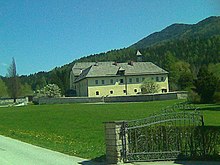Falkenburg (municipality of Irdning-Donnersbachtal)
|
Falkenburg ( Rotte ) locality |
||
|---|---|---|
|
|
||
| Basic data | ||
| Pole. District , state | Liezen (LI), Styria | |
| Judicial district | Liezen | |
| Pole. local community | Irdning-Donnersbachtal ( KG Irdning ) | |
| Coordinates | 47 ° 30 '4 " N , 14 ° 6' 8" O | |
| height | 660 m above sea level A. | |
| Residents of the village | 1068 (January 1, 2020) | |
| Building status | 223 (2001) | |
| Statistical identification | ||
| Locality code | 15790 | |
| Counting district / district | Irdning and Falkenburg (61 257 000) | |
| Source: STAT : index of places ; BEV : GEONAM ; GIS-Stmk | ||
Falkenburg is an Austrian village in the west of the municipality of Irdning-Donnersbachtal (Styria). The district got its name from the Falkenburg of the same name, which has been a Capuchin monastery since 1711 . The place has 921 inhabitants.
geography
The district of Falkenburg is 661 m above sea level. A. To the north, the Enns forms the border with the municipality of Stainach-Pürgg , to the east the town of Irdning. In the south is the place Donnersbach and in the west of the municipality Altirdning . In the northern third of Falkenburg lies the Irdninger Moos , which is partly a Natura 2000 protected area.
History of the monastery
→ Main article: Capuchin monastery Irdning
The present monastery was built in 1615 by Hans Praunfalk as a hunting lodge. Sigismund Friedrich Baron von Welsersheimb gave his hunting lodge, the Falkenburg, to the Capuchins in 1711 at the request of his wife, who had recently died, and had it converted into a monastery. On February 7, 1718, the church was opened in honor of St. Foster father Josef , consecrated by Josef Graf , the then Prince-Bishop of Seckau.
The baron lived in the monastery for a few years. A monastery library has been housed in its two rooms, which still have the stucco ceilings from that time, since the mid-19th century.
In 1777 it was almost destroyed by flames, part burned down and was rebuilt.
In 1941 the monastery was occupied by the military, but was allowed to continue to be looked after by a priest, in 1945 it returned completely to the property of the Capuchins. From 1949 to 1968, parts of the monastery served as a retreat house .
The monastery was renovated in 1998/1999 and has since served as a retreat house again.
literature
- Walter Brunner: Irdning. History of a Upper Styrian market . Irdning 1990

